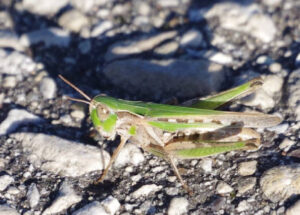Note: All links below go to external sites.
Howdy, BugFans,
The Slant-faced pasture grasshopper is the BugLady’s new, favorite grasshopper (well, not really – grasshopper-wise, her heart belongs to the lichen-y-looking Pine tree spur-throated grasshopper). The two species aren’t closely related, but they do have something in common – they sat still long enough for the BugLady to photograph them.
Slant-faced pasture grasshoppers/Pasture Grasshoppers/Pasture locusts (Orphulella speciosa) are short-horned (short-antennaed) grasshoppers in the family Acrididae. They’re in the subfamily Gomphocerinae, known variously as the Slant-faced Grasshoppers, the Stridulating slant-faced grasshoppers, and the Tooth-legged grasshoppers (because males, and often females, have “a row of pegs” on the inner surface of their thighs – all the better to make music with, my dear). The Gomphocerinae have a pair of disc-like hearing organs (tympana) on the first abdominal segment, noticeably-pointed heads and backward-slanting faces, and mostly-clear wings. Eric Eaton, in the Kaufman Field Guide to Insects of North America, says that “Slant-faced grasshoppers are disguised by their shape and are often striped to further their resemblance to grasses.”
SFPGs are found from the Rockies east to the Atlantic and from northern Mexico to southern Canada. They live in sunny patches of shorter grass interspersed in tall and mixed-grass in prairies, and in grazed and mowed areas (and in the parking lot at Riveredge Nature Center). In Wisconsin, they’re most common south of the Tension Zone, where they’re out and about during mid-summer.
Because this grasshopper is considered a pastureland pest that runs with a bad crowd of other pastureland grasshoppers, its biography has been pretty well outlined (it’s often the most common species in the gang, but it’s smaller than the others, so it may not have quite as large an impact).
SFPGs are sexually dimorphic, with females considerably larger than males. Adults come in a variety of colors
- https://bugguide.net/node/view/1346014/bgimage
- https://bugguide.net/node/view/1323359/bgimage
- https://bugguide.net/node/view/1011178/bgimage
- https://bugguide.net/node/view/688173/bgimage
Nymphs’ antennae and wings grow as they mature, and they may change colors and patterns before reaching adulthood. Not surprisingly, they eat grass, and like many other grasshoppers, supplement their diet (opportunistically) with scavenged bits of (dead) fellow arthropods. The list of grasses they eat is impressive and includes Kentucky bluegrass (which is not native), reed canary grass (which may or may not be native), dropseeds, Junegrass, big and little bluestem, sideoats grama, and more, plus a few sedges. Caveat: finding one in the wild in the act of eating is tricky, and many conclusions about their diet have been drawn from grasshoppers in terrariums or from examining the contents of grasshoppers’ crops. They’re not picky – they feed first on whatever grasses are most abundant, hanging head up or head down on the grass as they feed.
Grasshoppers, of course, are an important part of the menu of a wide variety of birds and other animals.
Males court with sound, by stridulating – rubbing the inside surface of a hind leg against raised veins in the top (front) wing to make what’s described as a faint ticking sound. Males stalk their prospective mates and then pounce without warning. They may remain “in copulo” for five or more hours, and if they are disturbed, he stridulates some more to get her attention. Populations in a small area may mate simultaneously. In summer, females deposit some pods, each containing 10 to 13 eggs, on the soil surface among the grass plants, and the grasshopper nymphs hatch the following spring.
The vocabulary word for the day is phytophilous (“plant loving”). Grasses are the SFPG’s food of choice, and they also live in and perch on grasses. At night, they retreat to the base of the plant, a few inches above the ground. They climb back up the stem and bask for a few hours after sunrise, and as the day heats up, they become more active.
Adults have long wings and are strong flyers, though a local flight may only take them four or five feet. Their basic range remains fairly constant, and individual grasshoppers tend to stay pretty close to home for generations, as populations rise and fall. When population density increases and food becomes scarce, they sometimes disperse/swarm. An outbreak was initiated in western Iowa in 1934 to 1937 when populations of the SFPG and its confreres reached 30 to 100 individuals per square yard. According to Robert Pfadt, in the Wyoming Agricultural Experiment Station Bulletin 912 (2001), “In many of the pastures all green vegetation was eaten to the ground by the first of July and all new shoots were consumed as fast as they appeared. The scarcity of food induced populations to disperse, presumably to seek better grazing.” Sometimes, he says, they needed to disperse only as far as freshly mowed roadsides in their search for succulent, green vegetation.
For an account of some world-class swarms in New England (by a different species) go through this blog (we sure had great vocabularies back then!).
The BugLady
